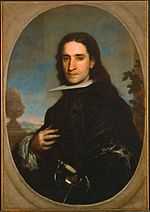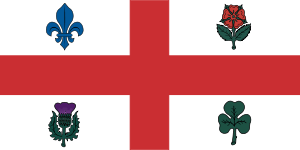Van Horne Mansion
| Van Horne Mansion | |
|---|---|
 The Van Horne Mansion, c. 1890 | |
| General information | |
| Type | Private house |
| Location | Golden Square Mile |
| Address | Sherbrooke Street, Montreal, Quebec |
| Construction started | 1869 |
| Demolished | 1973 |
| Landlord |
John Hamilton Sir William Van Horne |
| Design and construction | |
| Architect | J. W. Hopkins |
The Van Horne Mansion was a classic greystone house on Sherbrooke Street at the corner of Stanley Street in Montreal's Golden Square Mile. It was built in 1869 for The Hon. John Hamilton, President of the Merchant's Bank of Montreal.[1] In 1889, Sir William Cornelius Van Horne, President of the Canadian Pacific Railway, purchased the property and it remained in his family until it was controversially demolished in 1973. Despite the public outcry over its proposed destruction, Mayor Jean Drapeau declared that it could not be preserved for cultural reasons as it was not part of Quebec's culture, its history being Anglo Canadian, not French Canadian. With Drapeau's support, it was bulldozed in the middle of the night by developer David Azrieli, who replaced it with a concrete tower block.
History

Van Horne hired Bruce Price's architectural firm, who had done much of the work for the Canadian Pacific Railway, to enlarge the old Hamilton house to fifty-two rooms.
It was Edward Colonna (died 1948), an architect who had previously worked for Louis Comfort Tiffany before being hired by Price, who carried out the alterations to the Van Horne house. Colonna redid the entire ground floor and possibly much of the first floor, creating a spacious area with well-proportioned rooms and plenty of wall-space for Van Horne's art collection. The interior of Van Horne's house, from its fireplaces, ceilings and gold leaf walls, was the first example of art nouveau in Canada.[2] Van Horne claimed to like homes "big and bulky like myself",[3] but he had one of the best private art and pottery collections in North America and wanted a house he could share with it. The building was damaged by a fire on Monday, April 3, 1933, which led to the loss of part of Van Horne's private art collection.
Van Horne Art Collection
As a child, Van Horne collected fossils. He was also an excellent violinist and artist in his own right. When he was older, Van Horne was not just a serious collector, he had a passion for art: "A picture that you feel you do not really want is always an incubus and a source of dissatisfaction".[2]
He started collecting on his business trips around the world in the 1880s. By 1892, he had confidence enough in his knowledge to catalogue his most prized possessions, now found in the Montreal Museum of Fine Arts. He not only built up the most important collection in Canada, but added to it a comprehensive library on art history. He was meticulous in not just his choice of paintings, but also in his studies into the lives of the artists too. His collection featured the works of Velázquez, Hals, Rembrandt, Hogarth, Gainsborough, Reynolds, Constable and Turner.[4] He also collected many modern works, and in his catalogue of 1892, all but two of the forty nine works listed were from the 19th century.[2] In 1926 Caroline Pierson, the granddaughter of Allard Pierson, visited his daughter Adeline van Horne, and after viewing the collection, she wrote a letter describing what she saw, mentioning 4 Rembrandts, 4 Frans Hals, and a Bol and a Fabricius in the "red room".[5] In April 1933 a fire damaged some of the paintings, but the same year Frits Lugt paid a visit to an exhibition of the collection and made notes about several of the same paintings, indicating they were not all lost.[5] In 1972 Ernst van de Wetering and Professor Levie, as representatives of the Rembrandt Research Project, paid a visit to Mrs. Margaret Van Horne-Hannon, widow of grandson Billy van Horne, to inspect the 4 Rembrandts.[5] One was stolen before they could inspect it, and of the remaining three, they only authenticated "The Young Rabbi".[5]
-

Portrait of Samuel Ampzing by Frans Hals
-

Portrait of a Nobleman by Bartolomé Esteban Murillo
-

Portrait of a Gentleman from the Casa de Leiva by El Greco
-
.jpg)
Head of a young neapolitan girl by Pierre-Auguste Renoir
The treasures in the Van Horne mansion also included one of the best collections in North America of ancient Japanese porcelain and pottery. Typically, Van Horne became an expert on the art of firing and judging the overall finish of a specimen. His knowledge and collection earned him an invitaton to visit Japan as the personal guest of Meiji, Emperor of Japan.[6]
Demolition
This architectural gem of Montreal was controversially torn down by developer David Azrieli in 1973 under the mayoralty of Jean Drapeau, who declared that it was impossible to preserve it for cultural reasons because it was not part of Quebec's culture - Hamilton and Van Horne being Anglophone Quebecers. It was replaced by a sixteen storey concrete tower. The mansion's destruction sparked the creation of the heritage preservation group Save Montreal.[7] Journalist, William Weintraub includes the house and its demolition in his 1993 documentary, The Rise and Fall of English Montreal, identifying the significance of the building to the local Anglo community's heritage. The Sofitel Hotel today stands at the spot once occupied by the Van Horne mansion.[8]
References
- ↑ Van Horne Mansion at IMTL.org
- ↑ 2.0 2.1 2.2 From Telegrapher to Titan: The Life of William C. Van Horne - Valerie Knowles (2004)
- ↑ The Square Mile (1987), by Donald MacKay
- ↑ See Finding aid for Van Horne Family "Fonds CA OTAG SC065" on Art Gallery of Ontario website
- ↑ 5.0 5.1 5.2 5.3 De Van Horne collectie: Montreal 1926, 1933 en 1972 by Mary Eggermont-Molenaar
- ↑ Canada's Entrepreneurs: From The Fur Trade to the 1929 Stock Market Crash - Andrew Ross & Andrew Smith (2012)
- ↑ Germain, Damaris; Damaris Rose (August 2000). "A Metropolis in Transition; Montreal's Built Form — French Heritage, Victorian Legacy and Modernist Ambitions". Montreal, The Quest for a Metropolis. Wiley. p. 88. ISBN 978-0-471-94907-7.
- ↑ John David Gravenor (2008-04-03). "Rubens, Rembrandt, Velasquez — Up in flames on Sherbrooke Street". Coolopolis. Retrieved 2008-04-05.
External links
- Van Horne Mansion (1870-1973): a Demolition That Changed the History of Heritage Preservation, by Martin Drouin in the Encyclopedia of French Cultural Heritage in North America
- Architectural Awareness in Montreal, Ronald T.Harvie, Tourism Montreal, October 2007
- The Museum that is Montreal, Kristian Gravenor, Montreal Mirror, October 23-29, 2003
- A Handbook For Montreal's Heritage, Heritage Montreal
Photographs
- Sir William Van Horne and grandson, 1909 - McCord Museum
- Van Horne Mansion Hallway, 1920 - McCord Museum
- Van Horne Mansion Library, 1920 - McCord Museum
- Van Horne Mansion Billiard Room, 1920 - McCord Museum
- Van Horne Mansion Living Room, 1920 - McCord Museum
- Van Horne Mansion Drawing Room, 1920 - McCord Museum
- Van Horne Mansion Fireplace, 1920 - McCord Museum
- Van Horne Mansion Dining Room, 1920 - McCord Museum
| ||||||||||||||||||||||||||||||||||||||||||||||||||||||||||
| |||||||||||||||||||||||||||||||||||||||||||||
